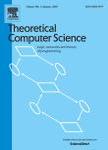版权所有:内蒙古大学图书馆 技术提供:维普资讯• 智图
内蒙古自治区呼和浩特市赛罕区大学西街235号 邮编: 010021

作者机构:Univ Roma La Sapienza Dipartimento Informat & Sistemist I-00198 Rome Italy Int Comp Sci Inst Berkeley CA 94704 USA Int Comp Sci Inst Berkeley CA 94704 USA Univ Calif Berkeley Berkeley CA 94704 USA
出 版 物:《THEORETICAL COMPUTER SCIENCE》 (理论计算机科学)
年 卷 期:1999年第221卷第1-2期
页 面:19-39页
核心收录:
学科分类:08[工学] 0812[工学-计算机科学与技术(可授工学、理学学位)]
基 金:EU ESPRIT, (20244) National Science Foundation, NSF, (CCR-9304722, NCR-9416101) Ministry of Scientific Research, Egypt, MSR
主 题:online algorithms competitive analysis routing optical networks
摘 要:The paper deals with on-line routing in wavelength division multiplexing (WDM) optical networks. A sequence of requests arrives over time, each is a pair of nodes to be connected by a path. The problem is to assign a wavelength and a path to each pair, so that no two paths sharing a link are assigned the same wavelength. The goal is to minimize the number of wavelengths used to establish all connections. Raghavan and Upfal (Proc. 26th Annual Symp. on Theory of Computing, 1994, pp. 133-143) considered the off-line version of the problem, which was further studied in Aumann and Rabani (Proc. 6th ACM-SIAM Symp. on Discrete Algorithms, 1995, pp. 567-576), Kaklamanis and Persiano (Proc. 4th Annual European Symp. on Algorithms, Lecture Notes in Computer Science, vol. 1136, Springer, Berlin, 1996, pp. 460-470), Mihail et al. (Proc. 36th IEEE Annual Symp. on Foundations of Computer Science, 1995, pp. 548-557), Rabani, (Proc. 37th Annual Symp. on Foundations of Computer Science, 1996, pp. 400-409). For a line topology, the problem is the well-studied interval graph coloring problem. On-line algorithms for this problem have been analyzed in Kierstead and Trotter (Congr. Numer. 33 (1981) 143-153). We consider trees, trees of rings, and meshes topologies, previously studied in the off-line case. We give on-line algorithms with competitive ratio O(log n) for all these topologies. We give a matching Omega(log n) lower bound for meshes. We also prove that any algorithm for trees cannot have competitive ratio better than Omega(log n/log log n). We also consider the problem where every edge is associated with parallel links. While in WDM technology, a fiber link requires different wavelengths for every transmission, space division multiplexing technology allows parallel links for a single wavelength, at an additional cost. Thus, it may be beneficial in terms of network economics to combine between the two technologies (this is indeed done in practice). For arbitrary networks with Om